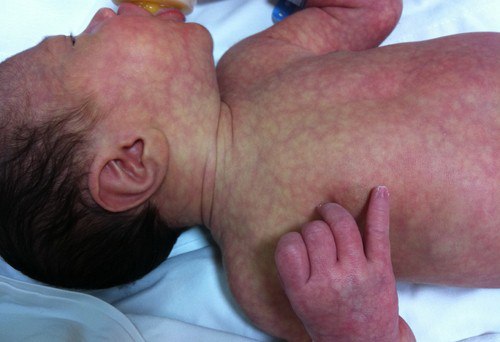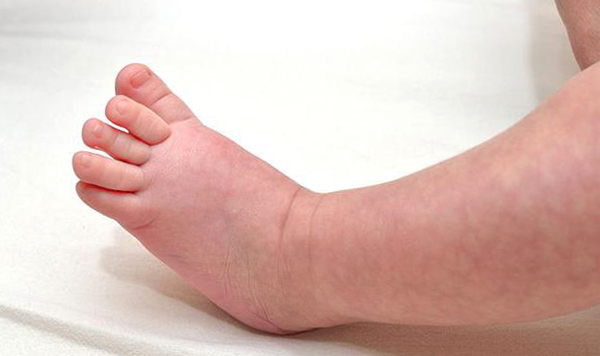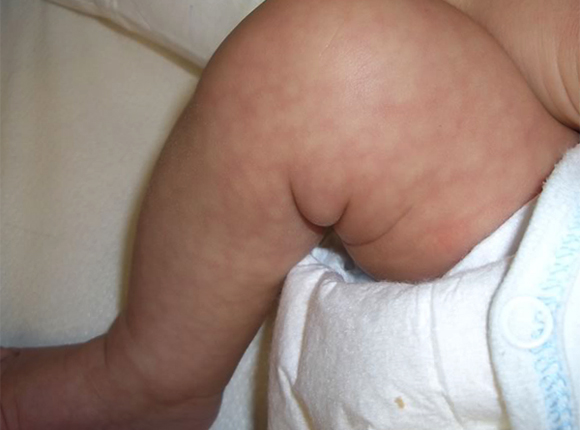Marbled leather. Is marbled skin in a baby a disease, a symptom or just a feature?
On TV screens and in glossy magazines we often see beautiful, plump babies with soft pink skin. Therefore, it has been ingrained in our minds that a healthy baby should have an attractive epidermis of a uniform, pleasant shade. But is it worth panicking if your newborn baby’s skin looks different, and as soon as the little one starts crying, the body generally takes on a reddish-bluish uneven color?
Let's try to understand this difficult matter and find out why a newborn baby has marbled skin and whether it is worth treating.
Why does the baby have a pattern on his body?
If you notice a bluish-reddish pattern on your baby’s body, this may indicate autonomic dysfunction. That is vegetative system The newborn’s capillaries, which should quickly respond to external changes, are not yet formed well enough, and they simply do not have time to cope with their function.
Some vessels have not yet joined coordinated work and narrow too quickly. In these places, the baby's epidermis turns blue. And where the capillaries do not block the movement of blood, on the contrary, the skin turns red. This color of the epidermis is called marble.
If we talk about whether marbled skin in a child is considered normal or not, then the answer is most likely positive. But there are a number of points that are worth paying attention to. Let's talk about this in more detail.
So, if you notice that your baby’s skin tone changes periodically, for example, when changing clothes, when the baby freezes a little, then in such cases the marbled epidermis is the physiology of a newborn. This phenomenon most often goes away by the age of six months, when the child’s blood vessels adapt and begin to work harmoniously. Such physiological phenomena do not require any treatment.
But it also happens that the marble pattern covers the entire body of the child, and the baby’s behavior is alarming, in which case a doctor’s consultation is necessary. If you notice that the newborn is too pale, sweats a lot, is lethargic, or, conversely, is unusually excited, his lips and nasolabial triangle turned blue, take your temperature and call a doctor.
All of the above reactions most often indicate hyperthermia (overheating), and if there is a fever, then consultation with a pediatrician is required.
Reasons why the baby's epidermis has an unusual color
As you already understand, one of the reasons for a child’s marbled skin may be the physiology of the newborn, but there are others that are worth considering:
- Prematurity. Many babies born ahead of schedule, there is autonomic dysfunction, which was already mentioned above;
- Fetal hypoxia during pregnancy and childbirth. This phenomenon also negatively affects normal functioning vascular system;
- Congenital heart disease, anemia and rickets also provoke disruptions in the functioning of the circulatory system;
- Congenital disorder of brain function;
- Overfeeding. True, some doctors dispute this possibility, but other experts do not exclude such a reason.
Does marble pattern need to be treated?

As already mentioned, if marbled skin appears in one month old baby periodically, then by six months everything should be back to normal.
In cases where the marble pattern of your baby’s epidermis is caused by one of the diseases mentioned above, the pediatrician observing you should prescribe appropriate treatment for you.
With this approach, the color of your child's epidermis will soon return to normal. After all, this “imperfection” is only a symptom of a disease that will leave you as soon as the disease recedes.
For those babies whose skin marbling is caused by the immaturity of the vegetative-vascular system, the main treatment will be aimed at its development. Must be created optimal conditions to regulate vascular tone. A properly structured daily routine and lifestyle of the child helps to achieve this.
The baby should have balanced diet, daily stay outside, alternating sleep and wakefulness, physiotherapy and hardening procedures: air baths, dousing, rubbing.
Massage aimed at regulating blood circulation helps very well. You can do it yourself; to do this, ask your doctor to show you the basic techniques. There is nothing complicated about this massage; you can easily carry it out on your own.
Swimming is very beneficial for autonomic dysfunction. Therefore, many experts recommend training children in the pool. This trains his blood vessels and hardens him. In general, double benefit.
Often, for patterns on the skin, they prescribe medicines. Usually these are B vitamins and restorative drugs. But you should not take any medications without consulting a pediatrician.
Marbled skin in children over three years old
After three years, it will not be possible to say that the child’s epidermis has patterns due to the immaturity of the blood vessels. Of course, if “imperfections” appear once, for example, during hypothermia or high temperature, then this is not critical.
But if a growing baby’s skin marbling persists constantly, then consultation with specialists (cardiologist, neurologist, pediatrician, etc.) is indispensable. Experienced doctors will help you find the cause of the problem.
Now you know why such imperfections as marbled skin occur. To summarize all of the above, the following main points can be highlighted:

- Marbled leather- Not terrible disease, and a peculiar reaction blood vessels;
- In babies up to 6 months, the bluish-red color of the epidermis is most often physiological; after six months the pattern disappears. But it is worth remembering that if there are any other symptoms, you need to consult a doctor. It is especially important to monitor the temperature of a child with marbled skin to prevent overheating;
- If a similar phenomenon is observed in older children, then an individual approach is needed. Calmly, without nerves, we undergo examinations and find out the reason for the unusual color of the epidermis.
The main thing is, don’t panic, walk more with your baby, toughen him up, enjoy life - and everything will return to normal.
What is marbled leather? The color of human skin depends on blood circulation and the condition of skin vessels. Insufficient blood flow into the skin causes its pallor, excessive blood flow causes redness; creates blood stagnation bluish tint. Every person encounters this phenomenon in life, for example, during hypothermia, or, conversely, overheating of the body. At the same time, the skin color is uniform - it is either pale or reddened.
There is a condition of the skin when it acquires an uneven color, reminiscent of marble mosaic, consisting of many light and dark spots. Marbled skin coloring is not independent disease, and the so-called marbling syndrome. It can occur at any age, but more often in children, from a variety of reasons: internal or external factors , which ultimately affect the condition of blood vessels. Appearance marble stains
on the skin and is caused by uneven dilation and constriction of blood vessels.
Important! Marble skin syndrome should not be confused with marble disease, which develops in the bones, is severe, and has nothing to do with the skin.
Why does skin marbling occur?
- Dysregulation of vascular tone.
- Vegetative reactions of blood vessels to changes in temperature (body and external environment).
- Vascular diseases (atherosclerosis, vasculitis, periarteritis and others).
- Disturbances in the blood clotting system.
- Infectious diseases.
- Tuberculosis.
- Venereal diseases.
- Hormonal disorders (hyperfunction of the parathyroid glands).
- Acute organ diseases abdominal cavity(pancreatitis, hepatitis).
- Heart failure.
- Neurological diseases (paralysis, polyneuritis, polyneuropathy).
- Hypertonic disease.
- Collagenosis (lupus erythematosus, rheumatoid arthritis).
- Exposure to toxins, particularly alcohol.
- Taking certain medications (Quinidine, Amantadine).
The so-called idiopathic marbling is also rare, the cause of which has not been established.
What are the causes of marbling of the skin in children?
The causes of marbled skin in a child are different. Most often it develops in early period- in infants. Naturally, a mother who discovers the appearance of spotty skin on her baby becomes concerned, she seeks advice from a doctor, and does the right thing.

Marble skin color in infants is a fairly common phenomenon, in most cases it is a variant of the norm. The reasons for marbled skin in a baby lie in the structure of its skin and blood vessels: the skin is extremely thin, there is no thick stratum corneum, and the blood vessels are visible through it. On the other hand, central nervous system
- The baby is not yet perfect, she is not able to regulate vascular tone, as in adults. Therefore, the slightest influence can lead to their expansion in some areas and narrowing in others, which gives such coloring. This is normal in the following cases:
- when the baby is not dressed warmly enough and is cold;
- on the contrary, when the child’s body overheats; when the baby is overfed and enters the vessels large quantity
- liquid they expand, forming bluish spots; after long labor
- that affected the baby’s central nervous system (prolonged passage of the head and its hypoxia);
- after the umbilical cord is wrapped around the neck during childbirth; during acute infections
with an increase in body temperature.
However, in 3-4% of cases, marbled skin color in newborns indicates poor health, it is a symptom of the following diseases:
- cardiovascular pathology ( birth defects heart, vascular abnormalities, myocarditis);
- blood diseases (leukemia, erythremia, lymphoma);
- congenital telangiectatic disease (dilation of small vessels);

- Down's disease is a chromosomal disease accompanied by vascular pathology;
- Edwards syndrome is a severe chromosomal disease when a child is born with several anomalies: skull, skeleton, heart defects, kidney defects and other pathologies.

Important! There is no need to panic if your baby develops marbled skin coloring; most likely, this is a variant of the norm. But it is also necessary to show the child to a doctor in order not to miss a serious illness, as well as to receive recommendations for proper care.
When does marbled skin appear in adults?
As a normal, transient phenomenon, marbled skin occurs infrequently in adults, compared with a similar phenomenon in childhood. This happens when the body overheats, for example, after a bath, sauna, applying a heating pad, or during hypothermia. The skin takes on a mosaic, reticular pattern consisting of pale and bluish spots.
The most common causes of marbled skin in adults are diseases: infectious, sexually transmitted, cardiovascular, oncological, endocrine.
- This skin condition in adults is called livedo, from the Latin livedo, meaning bruise. Marbling syndrome in adults can have 3 clinical forms: Livedo reticularis
- Livedo reticularis (from the Latin reticula - mesh). It appears as small reddish or bluish spots on the skin of the torso and limbs, with a symmetrical arrangement. There are 2 options: Livedo reticularis a calore, that is, arising from heat (calor - heat), and Livedo reticularis a frigore, appearing from cold (frigo - cold). In most cases, this is a transient phenomenon that goes away after the ambient temperature normalizes. But such marbling may also indicate the presence of diseases. internal organs

- , so examination in such a situation is necessary. Lenticular livedo - Livedo lenticularis (from the Latin lenticula - lentil), manifested by the presence of many small bluish spots on the skin of the legs. This is a symptom active tuberculosis
- lungs, requiring immediate examination. Tree-like (bunch-like) livedo - Livedo racemosa (branched - lat.), has the form along the body in the form of mesh branches of a bluish color. Occurs in many serious diseases that require examination and treatment:
- hypertension, atherosclerosis, heart disease;
- collagenosis (lupus erythematosus, rheumatism, rheumatoid arthritis);
- chronic alcoholism;
- oncological diseases;
- infectious diseases (tuberculosis, dysentery, malaria);
- chronic inflammatory diseases(sinusitis, tonsillitis and others);
- after severe traumatic brain injury;
- at vegetative-vascular dystonia(VSD).

Important! Marbled skin in adults almost always signals some kind of disease, so you need to consult a doctor who will prescribe an examination.
More often, tree-like marbling is located on the skin of the hands and feet, but is often widespread. VSD is characterized by the isolated appearance of marbled skin on the palms.
Marbled skin may indicate both temporary, transient disorders and serious illnesses. Its appearance in both adults and children requires mandatory visit doctor, finding out the cause of the phenomenon and, if necessary, prescribing treatment.
The skin of newborn babies is distinguished by its tenderness, smoothness and velvety. Immediately after birth, the color of the skin of infants may be gray or bluish, but after a few hours, if everything is fine with the newborn baby, the body becomes soft pink. However, the skin color can sometimes be marbled, which is very scary for parents.
Causes of marbled skin in infants
Blood capillaries in a newborn's skin can form for several months after birth, so don't sound the alarm if your baby's body isn't pink. The marbled color of the skin of a baby who was born prematurely is considered quite normal occurrence, in no way related to the development of pathological processes.
The cause of marbled skin in a baby may also be an imperfect thermoregulation system. A sharp decline temperature, when the body has not yet had time to rebuild itself, and this shade of the baby’s skin appears. This process becomes especially noticeable when changing clothes.
The mother may notice that the baby’s marble-colored skin is not observed throughout the entire body, but only in a certain area. This phenomenon occurs when a child’s arm, leg, or other part of the body is frozen. As soon as you dress your baby warmly and he warms up, the skin will acquire a normal pink tint.
Sometimes the reasons for changes in skin color may lie in the development of serious pathologies - generalized phlebectasia or telangiectatic marbled skin. This pathological condition caused by constantly dilated surface capillaries that never return to normal. This phenomenon occurs extremely rarely and mainly in children of northern peoples.
Usually, the marbled color of a baby’s skin disappears before the newborn is six months old, without requiring the attention of specialists.
signs of marbled skin in infants
Despite the fact that marbled skin color in the first months of a newborn’s life is considered normal, young parents often begin to sound the alarm.
And they do the right thing if, with such an unusual shade of the baby’s skin, they also detect the following signs:

- excessive sweating;
- pallor;
- lethargy or increased excitability;
- cyanosis of the lips and nasolabial triangle.
These signs may indicate development dangerous diseases, so if you find them in your child, call a doctor immediately.
This condition of the newborn can be the result of the following processes:
- intrauterine fetal hypoxia during pregnancy;
- congenital heart defects;
- rickets;
- anemia.
If the baby’s parents suffer from vegetative-vascular dystonia, their baby could inherit this disease, which manifests itself in this way after birth.
treatment of marbled skin in infants

In the case where infants have marbled skin as a result of the development of certain diseases, treatment will be required immediately after birth. After the root cause of this condition of the skin is eliminated, it will acquire a natural, healthy shade.
If marbling is caused by the immaturity of the vegetative-vascular system, the task of the doctor and parents is to create favorable conditions for its full development. Parents must take care of proper nutrition baby, provide regular long walks for fresh air, alternation of sleep and wakefulness.
General hardening will be beneficial child's body, consisting of procedures such as dousing, rubbing, air baths, as well as therapeutic exercises. Marbled skin of a baby becomes an indication for prescribing for a baby restoratives and vitamins, especially group B.
If you discover that your child has marbled skin color, do not worry ahead of time, contact a good specialist, which will indicate the reasons for this condition of the skin.
A disease such as marbled skin in a newborn is quite common and has characteristic symptoms. The skin of a newly born baby is tender, velvety, elastic, with an abundant blood supply. A baby's skin can be easily damaged, so even when caring for it, you need to be careful. For example, under no circumstances should you rub your baby with a towel, but only gently blot it dry. Negligent treatment of the baby's dermis can lead to the formation of diaper rash and small pustules. But marbling of the skin in infants is due to other factors.
Symptoms of pathology
With this disease, the skin in children becomes marbled or spotted due to a large number of blood vessels that have not formed and are located too close to the surface of the skin. Some vessels narrow, causing a blue color to appear, while others dilate, resulting in a red color.
Doctors associate the appearance of this disease with shortcomings in the activity of the central nervous system. Marbled skin in a baby can also indicate the development of pathologies such as: dropsy of the brain, high intracranial pressure and the presence of a cyst.
Return to contents
Factors provoking the disease
The reasons why the disease may appear are quite extensive. Most often, the development of pathology occurs due to the following factors: 
- Long-term feeding. If the baby stays at the mother's breast for a long time and overfeeding occurs, then a marble pattern appears on the skin due to the fact that the blood vessels are oversaturated with blood. If milk enters the baby’s body in large quantities, this can lead to stretching of the walls of blood vessels, which leads to a loss of their elasticity and elasticity.
- Violation of vascular tone. Marbled skin especially affects babies whose labor took too long. This is why there are injuries to the head and part of the spine in the neck due to additional stress.
- Anemia and hypoxia during pregnancy. The presence of such phenomena in women has a negative impact on circulatory system baby.
- Heart diseases. Marbling in newborns can also indicate heart pathologies. For this reason, after birth, the child is referred not only to a neurologist, but also to a cardiologist for examination.
- Heredity. The phenomenon can be inherited from one of the parents if he suffers from vegetative-vascular dystonia.
Return to contents
Can marbling be considered normal?
If the appearance of marbling of the skin is a periodic phenomenon in the baby and appears only with hypothermia and overfeeding, then it can be argued that this is a relatively normal condition, but requires additional observation.
Most often, this phenomenon disappears by six months, when the vessels can independently maintain their tone and not be influenced by external factors.
 But if vascular network on the epidermis of the baby is very pronounced and this causes alarm, then you need to pay attention to the following additional signs:
But if vascular network on the epidermis of the baby is very pronounced and this causes alarm, then you need to pay attention to the following additional signs:
- frequent sweating (with in good condition babies should not sweat at all, because their thermoregulation is not yet as well developed as that of adults, so the appearance of sweat in a child who has recently been born is an alarming sign);
- the manifestation of two opposites is possible - lethargy or hyperexcitability;
- bluishness of the lips and the triangle around them and the nose;
If the baby has marble mesh, it is necessary to constantly measure the baby’s temperature (such signs may indicate hyperthermia) and call a doctor.
Return to contents
Treatment in a child
Often this phenomenon does not pose any danger to the child’s life. With age, the baby's skin hardens along with the subcutaneous vessels. In addition, the nervous system is finally formed. But despite everything, doctors recommend bringing the baby for additional examination to a neurologist.
If the manifestation of the vascular network causes mistrust in the doctor, then he should prescribe additional examinations: ultrasound of the head, neurosonography. In addition, there are diseases of the dermis in children, for which characteristic feature there is marbling.
 If the manifestation of the vascular network is not associated with severe pathologies, then the manifestation of this disease can be reduced. To do this, it is necessary to organize such living conditions for the baby that will support him vascular system in good shape. These conditions include:
If the manifestation of the vascular network is not associated with severe pathologies, then the manifestation of this disease can be reduced. To do this, it is necessary to organize such living conditions for the baby that will support him vascular system in good shape. These conditions include:
- regular massages;
- special gymnastics classes, which can be conducted by both a specialist and the parents themselves;
- spending a long time outdoors;
- regulation of nutrition to avoid overeating by the baby;
- Overheating is contraindicated for babies who are prone to developing marbled skin.
In addition, parents need to know about this form of marbled skin, which is congenital. With this feature of the baby’s skin, the network of blood vessels does not go away, even if the baby is warmed up.
Marbled skin is a common occurrence in children who live in a cold room.
The phenomenon of a bright vascular network may also indicate a number of congenital diseases:
- generalized phlebectasia, in which vascular defects and skin atrophy are diagnosed;
- congenital syphilis.
Sometimes a marbled shade of the skin can appear with Down and Edwards syndromes. If the vascular network appears on lower limbs, then this may indicate atopic dermatitis.
From all of the above, we can conclude that marbled skin is not a disease, but a temporary phenomenon that is caused by the underdevelopment of the baby’s blood vessels or is a symptom of some serious illness. Therefore, if the vascular network appears quite often and intensely, then to be on the safe side it is better to consult a doctor.
The skin of a newborn baby is delicate and thin, and therefore, when caring for it, you need to be extremely careful. So, children are not even allowed to dry themselves with a towel; their bodies can only be soaked in a towel. And you should only use soft towels that will not damage children's skin. Cotton diapers are also suitable for wiping.
If you don’t take care of your child’s skin, different symptoms may appear. skin diseases, which will bring the baby a lot of discomfort and unpleasant moments. One of the diseases that parents of a newborn child may encounter is marbled skin in the baby.
Blue skin can manifest itself in different ways; in some children, certain areas of the body change color, and there are also children whose whole body turns blue.
Signs and causes
This disease is one of the common problems that a newborn child and his parents have to face. Due to unformed blood vessels, nets of a different shade from the usual skin color begin to appear on the child’s body. The shade of the skin can vary from red to blue. Sometimes it even comes in purple, which doesn’t look attractive at all. 
These colors appear especially clearly at times when the child is warming up or, on the contrary, freezing. Signs of such skin manifestations include the following:
- Microcirculation disorder.
- Disruption of the nervous system.
All the reasons why a child’s skin has an unpleasant tint can be divided into two groups: physiological and pathological. The first two reasons can be called a normal phenomenon that also occurs in healthy children. And if we are talking about some pathologies, they are often accompanied by additional symptoms. 
The reasons for such a deviation include the following:
- Heredity. This can be said if one of the parents had vegetative-vascular diseases.
- Long lasting. Pediatricians say that a child should be fed as much as he can eat, since he himself can control the level of satiety. But this is not always correct, because some mothers have a lot of milk, which seems to never end. But you should not overfeed your child, as it will be difficult for him and marble skin may appear.
- Because of marbled skin, heart diseases can develop, so if this symptom appears, you need to show the baby to a cardiologist.
- Encephalopathy.
- Due to fetal anemia, a newborn baby may exhibit this symptom.
- Congenital heart defects.
- Due to the prolonged birth of a child, vegetative-vascular dysfunction may develop, which is manifested by a change in the color of the skin.
Above we talked about the duration of feeding the baby. But this is not the only reason for the bluish skin; it often appears due to the fact that the child suckles at the breast and makes an effort, tries. That is why similar symptom Most often observed in children who are breastfed.
Treatment
Despite the fact that this is a disease of its own kind, it does not require any special treatment. Often this symptom goes away on its own. In 95% of cases, the symptom disappears in the child by three months. Occasionally it persists for up to ten years. And in a small percentage of people it can last a lifetime.
But if your child does not have this symptom, but he feels well, you need to help him leave. To do this you need to do the following:
- Accustom your child to hardening. For this you can use different methods: air baths, dousing, rubbing. It is better to consult a doctor about this.
- Treat it in a timely manner.
- Massage.
- Physical activity. Exercises according to the child's age.
- Support immunity.
- , correctly distribute periods of rest and wakefulness.
- Prevent the disease.
After all, the child grows up and his body hardens. In addition, this deviation often goes away immediately after all the child’s organs are formed. But no matter how harmless the changes in the integument of the body may seem to you, the child needs to be seen by a doctor.
If a neurologist suspects the development of some disease, he will prescribe tests for the child. If everything is fine with the baby, then the doctor may prescribe harmless procedures: gymnastics or massage. In order to eliminate this symptom, you must adhere to the following recommendations:
- Spend a lot of time outdoors.
- Daily. You can take pine extracts once a week.
- Do not overheat the baby.
- Monitor the newborn's nutrition.
- Take swimming lessons if possible.
But if, in addition to changes in body color, the child exhibits other symptoms, then parents should be wary of this. TO dangerous symptoms the following should be included:
- Refusal to eat, poor weight gain.
- The baby's skin color is bright red.
- Increased sweating.
- Blue nasolabial triangle or lips.
- Blueness or, conversely, pallor in the groin area.
- Excitability or lethargy of the child.
- Unusual behavior.
You can notice bluish skin on a newborn baby by changing his clothes, especially if it is cold in the house or when there is a sharp cold snap outside. Sometimes the bluish tint of the baby’s body goes away immediately after the mother dresses the baby warmer. That is why similar problem children who live in cold areas or those who were born in winter time of the year.
A similar symptom also appears in cool water or after being removed from there. During or tantrums skin the child may turn blue because he has to strain. And as practice shows, most often such causes appear in children with light skin tones. Since it is not very noticeable on dark-skinned children.





